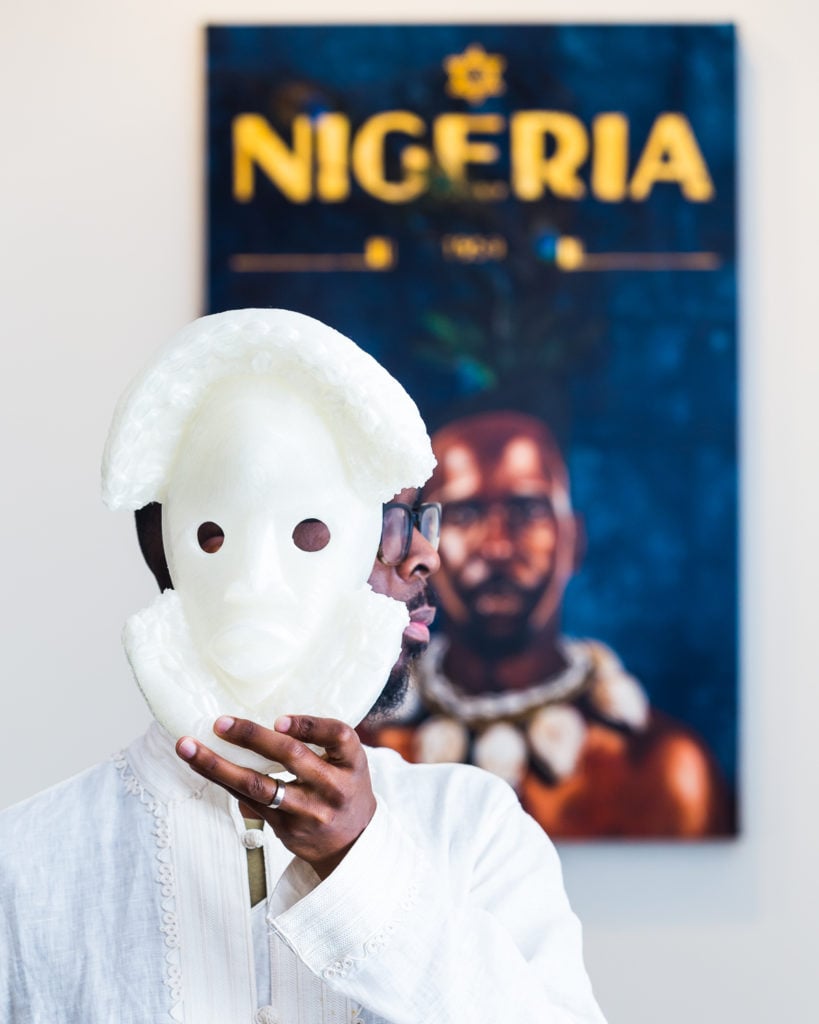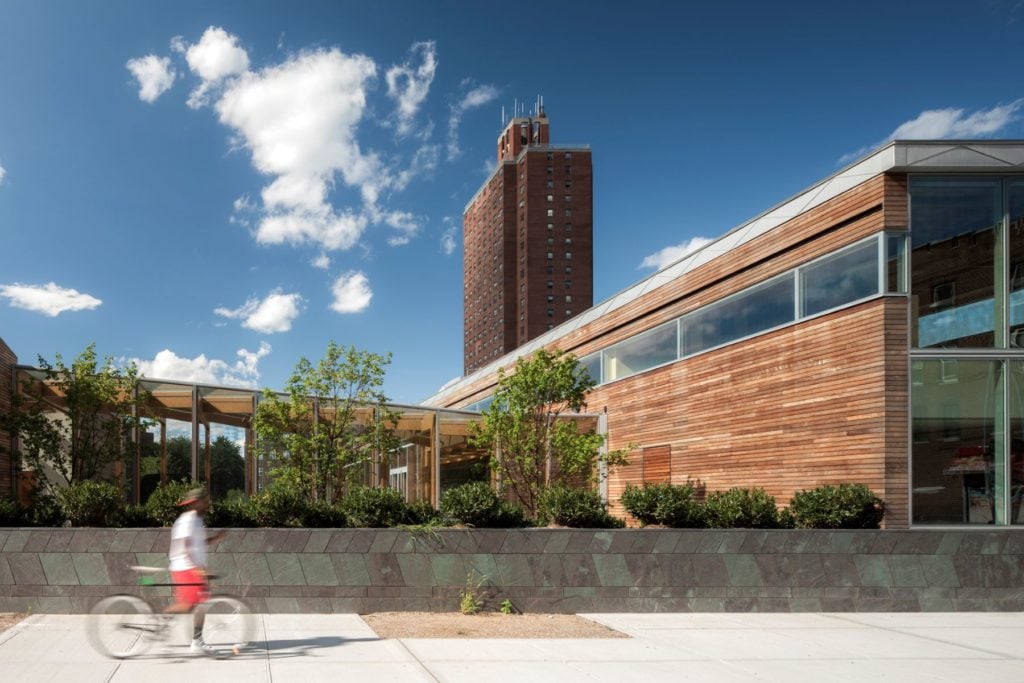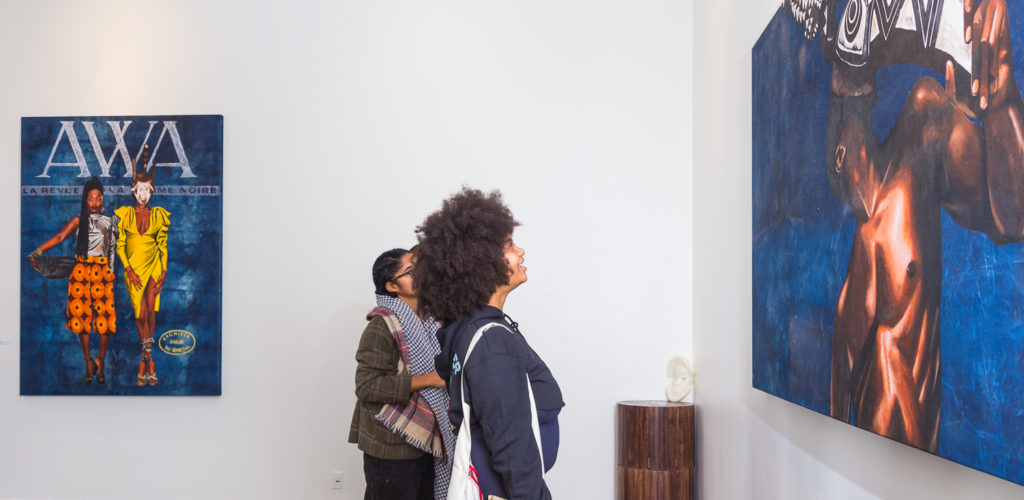On View
Fahamu Pecou’s Spiritually Charged Pop Painting About Black Identity Finds a Powerful Setting in Brooklyn
The community rallied to help fund Weeksville Heritage Center earlier this year. The Atlanta artist's show is part of a comeback.

The community rallied to help fund Weeksville Heritage Center earlier this year. The Atlanta artist's show is part of a comeback.

Stephanie Cash

Sometimes an exhibition and its venue are so in sync that they come together to yield layers of meaning and nuance. Such is the case with Fahamu Pecou’s show “Memory” at the Weeksville Heritage Center.
Located in the heart of modern-day Crown Heights in Brooklyn, Weeksville was a flourishing community of free black people that emerged in 1838, 11 years after New York State abolished slavery and 23 years before the Civil War. The center encompasses the landmarked Historic Hunterfly Road Houses and a contemporary visitors and education facility.
The Atlanta-based Pecou, known for works that explore notions of black male identity, was only vaguely familiar with Weeksville before curator Natalya Mills-Mayrena approached him about doing a show there. But the more he learned about the site, the more excited he became.
“Weeksville is not just a local treasure, it’s a national treasure, rich with literal traces of courageous black leaders, business people and visionaries,” says the artist, who was born in Brooklyn and raised in South Carolina. “You can walk into homes built by freed and newly freed black people who were working to assert black humanity in the American narrative. That space still exists and is relevant to our national conversation today.”
Like too many sites of African American history, Weeksville was almost lost earlier this year when a budget crisis threatened its closure. Following a story in the New York Times, the center raised $269,966 on GoFundMe from 4,284 individuals, exceeding its $200,000 goal. Weeksville president and executive director Rob Fields told Artnet that some major supporters subsequently stepped up, including the Ford Foundation and the city itself, to the total tune of $725,000. The center’s pending acceptance into the city’s Cultural Institutions Group—institutions on city-owned property that receive municipal funds to cover basic operating costs—will also provide dependable support.

Weeksville Heritage Center. Photo by Nic Lehoux.
“Weeksville makes you think about what blackness used to look like, what it looks like today, and what it could be in the future,” Mills-Mayrena says, reflecting on Weeksville’s location across the street from housing projects. She felt that Pecou’s exploration of such questions as “what does black look like now and how do we want to be represented” was on point for Weeksville.
Pecou, who received a PhD from Emory University in May 2018, is especially interested in how stereotypical representations in popular media inform and shape identity. Viewing representations of black men in the media and popular culture as problematic and troubling, the artist has spent his career seeking to broaden the conversation around black masculinity and to complicate the visual language around it. It’s his way of reclaiming a sense of humanity for himself and black men, he says—not unlike the founders and residents of Weeksville who asserted their own humanity on their own terms.

Installation view of Fahamu Pecou’s “Memory” at Weeksville Heritage Center. Photo by Dominique Sindayiganza.
In an April 2019 TEDx talk about the development of his practice, Pecou explained the diverse influences for his work. He spoke about the relevance to his work of the French psychoanalyst Jacques Lacan’s theory of mirroring: “One’s subjectivity is largely informed by external representations… we begin to take our cues about who we are based on images that reflect back to us who we believe ourselves to be.” But, he adds, it was the 1993 movie Menace II Society and its promise of a bleak, or nonexistent, future that profoundly affected him and set him on a path of self-discovery.
David Hammons once said, “Outrageously magical things happen when you mess around with a symbol.” Pecou works in the vein of artists like Hammons, Kehinde Wiley, and Sonya Clark, who unravel (sometimes literally) cultural associations and signifiers by repurposing such materials as Confederate flags, hair, and art-historical imagery, to powerful effect.

Installation view of Fahamu Pecou’s “Memory” at Weeksville Heritage Center. Photo by Dominique Sindayiganza.
Pecou’s paintings and drawings are always recognizable, and not just because he himself appears in most of them. In fact, he insists that these are not self-portraits. Each work begins with a photo shoot, with the artist performing preconceived notions of black masculinity, projecting a bravado that belies his introspective and intellectual nature.
A practitioner of Yoruba spirituality (Ifa), Pecou also often incorporates elements of African history and ritual into his work. In the five paintings and two drawings on view (and two 3-D prints of ceremonial masks) at Weeksville, Pecou employs African imagery and cultural references to speak to the lost sense of history in the African American community and the effort to reestablish ties to an origin that predates the trauma of enslavement.
Beyond African masks and ceremonial attire, he has added “aché”—a life-giving force present in all things—to completed paintings, in the form of delicate lines that swirl around figures. Since 2017, when Alison Saar introduced him to the spiritual attributes of colors within African American and African traditions, indigo has become a major element in his paintings. In addition to its role in the trans-Atlantic slave trade, indigo is the last visible color on the color spectrum, so he considers it a gateway to the spiritual. For the paintings in his recent series “Memory,” four of which are included in the Weeksville show, Pecou dyed his canvases with indigo, which, he says, allows him to introduce aché at the beginning of a work instead of at the end. The inky backgrounds lend a solemnity to the works not seen in his other series, where backgrounds of gold leaf or bright color achieve equally impactful results.

Installation view of Fahamu Pecou’s “Memory” at Weeksville Heritage Center. Photo by Dominique Sindayiganza.
Early in his career, Pecou depicted himself on the covers of major art publications. For the “Memory” series, he appears on the covers of vintage African magazines whose logos are rendered in diamond dust or gold leaf. In one, he stands next to a woman baring her very pregnant belly. Both are dressed in contemporary African fashion—which Pecou himself often sports—with ceremonial accoutrements as accessories and the sparkly “True Africa” logo splashed overhead.
The women in Pecou’s paintings are always revered and strong, as in the example of the two stylish women commanding the cover he depicts in AWA: la revue de la femme noire. The canvases in this series are saturated, literally and figuratively, with cultural memory. They assertively reclaim a past that is as uncertain as it is deeply felt.
Pecou’s work is both heady and accessible. With vibrant color, dynamic compositions, and visual swagger, it has immediate appeal. Pecou regularly shows at galleries in New York, Paris, and Dallas, but he reaches non-art audiences as well. A Pecou painting can be seen in nearly every episode of Black-ish, hanging prominently near the Johnson family’s front door. Others have appeared on the show Empire. A Pecou drawing graces the cover of Rion Amilcar Scott’s book The World Doesn’t Require You and a painting serves as the cover art for Jidenna’s new album 85 to Africa.
It’s not often that an artist’s work resonates so widely and deeply. The show at Weeksville adds another dimension and further demonstrates how far his themes can travel.
“Memory” is on view at Weeksville Heritage Center, Brooklyn, New York, through December 13, 2019.